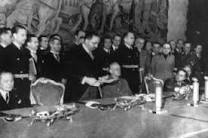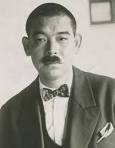IB History Paper 1-Japanese Expansionism Terms
1/28
There's no tags or description
Looks like no tags are added yet.
Name | Mastery | Learn | Test | Matching | Spaced |
|---|
No study sessions yet.
29 Terms
Humiliating Treaties
a series of agreements made between Asian countries— Western countries – during the 19th and early 20th centuries.[1] They were often signed following a military defeat suffered by the former party, or amid military threats made by the latter. Their terms specified obligations to be borne almost exclusively by the former party: provisions included the cession of territory, the payment of reparations, the opening of treaty ports, the relinquishment of the right to control tariffs and imports, and the granting of extraterritorial to foreign citizens.[2]
Meiji Restoration
The government became centralized around the figure of the emperor, and the political system now allowed people to pursue new opportunities.The main goal of the Meiji Restoration was to rapidly modernize Japan to a point of equality with other major powers
Zaibatsu
Japanese monopoly
Throwing off Asia
An essay by Fukuzawa that said that in order to advance as a country and be superior than other asians, japan had to become westernized.
Treaty of Shimonoseki
Ended Sino-Japanese war. China recognized the "full and complete independence and autonomy" of Joseon (the kingdom of Korea) and formally renounced China's traditional claims of imperial overlordship.
Treaty of Portsmouth
a treaty that formally ended the 1904–1905 Russo-Japanese War. It was signed on September 5, 1905,
Internationalism
Washington Treaty
Five-Power Treaty, was a treaty signed during 1922 among the major Allies of World War I, which agreed to prevent an arms race by limiting naval construction.
Four Power Treaty
In the Washington conference of 1921 the United States, France, the United Kingdom, and Japan agreed to consult with each other in the event of a future crisis in East Asia before taking action. This treaty replaced the Anglo-Japanese Treaty of 1902, which had been a source of some concern for the United States.
Kwantung Army
Formed in 1906 as a security force for the Kwantung Leased Territory and South Manchurian Railway Zone after the Russo-Japanese War of 1904–1905 and expanded into an army group during the Interwar period to support Japanese interests in China, Manchuria, and Mongolia.
Diet
Japanese parliament
Mukden Incident
On September 18, 1931, an explosion destroyed a section of railway track near the city of Mukden. The Japanese, who owned the railway, blamed Chinese nationalists for the incident and used the opportunity to retaliate and invade Manchuria.
Manchuria
Space of china invaded by Japan
Manchukuo
Formerly Manchuria
Anti-Comintern Pact
November 1936, anti-Communist pact concluded between Nazi Germany and the Empire of Japan on 25 November 1936 and was directed against the Communist Internationa
doka
Japanese term describing its ideology on how to rule colonies in the Greater East Asia Co-Prosperity Sphere through assimilation of colonised peoples
E.P. Tsurumi
Author who studied the life of female workers in Japan Sig.- Outlined the difficult labor and conditions females faced.
Kominka
Japanese term referring to the use of education, religion etc. to 'Japanise' colonial subjects.
Greater East Asian Co-prosperity Sphere
a pan-Asian union that the Empire of Japan tried to establish (the idea of a unified and self-sufficient bloc in the Asia-Pacific region under Japanese control.)
Pan-Asianism
an ideology aimed at creating a political and economic unity among Asian peoples
League of Nations
First worldwide intergovernmental organisation whose principal mission was to maintain world peace. It was founded on 10 January 1920 by the Paris Peace Conference that ended the First World War.
Kellogg-Briand Pact
an agreement to outlaw war signed on August 27, 1928. Called upon signatories to settle their disputes by peaceful means.
Lytton Report
LON trying to evaluate Japan invation. Blaming the Chinese for their anti-Japanese propaganda and refusal to compromise but branding Japan as an aggressor.
Isolationism
Neutrality Acts
Kept US isolationist
Between 1935 and 1937 Congress passed three "Neutrality Acts" that tried to keep the United States out of war, by making it illegal for Americans to sell or transport arms, or other war materials to belligerent nations.
Stimson Doctrine
“the United States would not recognize any treaty or agreement between Japan and China that violated U.S. rights or agreements to which the United States subscribed.”
enunciated in 1931, when Japanese troops took over Manchuria,
Basically that US believe that an aggressor cannot acquire territory by conquest alone, trying to be humanitarian.
Tripartite Act

Also known as the Berlin Pact, was an agreement between Germany, Italy, and Japan signed in Berlin on 27 September 1940.
created a defense alliance between the countries and was largely intended to deter the United States from entering the conflict.
Matsuoka

A Japanese diplomat and Minister of Foreign Affairs of the Empire of Japan during the early stages of World War II. He is best known for his defiant speech at the League of Nations in February 1933, ending Japan's participation in the organization.
General Tojo

Prime minister of Japan, general of the Imperial Japanese Army, and president of the Imperial Rule Assistance Association from 1941 to 1944 during World War II